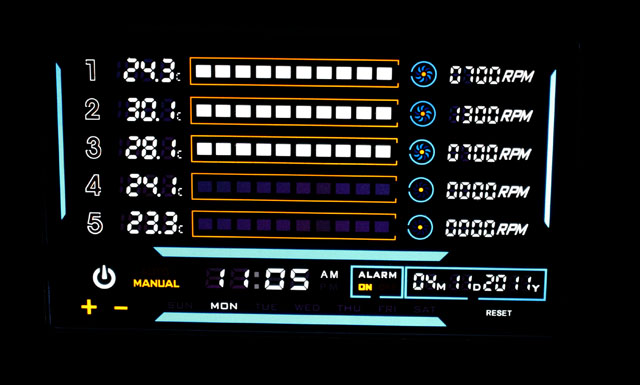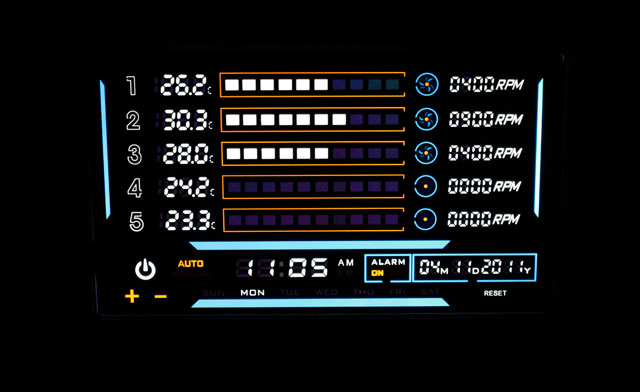NZXT Sentry LXE fan controller review
Installation
The installation is pretty simple, first you place the included cell coin battery into the battery holder, it's used to save settings when the power is turned off. Then you insert the PCI card into one of your case's empty PCI slots and you connect the Molex power cable to your power supply. The next step is to plug one end of the included power cable into the display and the other end into the rear of the PCI card. Connect your fans and place the temperature probes in the desired locations and you're ready to boot up your PC. Fan connector cables and temperature probes that aren't in use can be detached from the card to reduce cable clutter.
Testing
Using the Sentry LXE is pretty straightforward, but one disappointing fact is that only certain parts of the screen are responsive to touch. Before testing the screen I thought I could adjust the fan speed by sliding with my finger over the fan speed bars but that's not how the Sentry LXE works. You need to put the fan controller in manual mode and press twice on the fan channel you'd like to adjust and then use the plus and minus buttons to adjust the fan's RPM. When you adjust the fan speed the change isn't instantaneous, it takes a couple of seconds before the speed drops.
In auto mode the fan controller automatically adjusts the RPM of each fan, depending on the temperatures of the corresponding temperature probes. In manual mode you can adjust the RPMs at will, fan speeds can be configured from 3.7V (30%) to 12V (100%), and it's possible to completely turn fans off (0%). The device also lets you activate an alarm feature, the controller board has a buzzer that goes off when one of the measured temperatures exceeds a certain value. The threshold value can be configured for each of the five channels.
The screen is bright, it's easily visible in daylight but not so bright as to be blinding. The vertical visibility is pretty bad though, when I placed the display on top of my case I wasn't able to see anything from my chair. The touchscreen isn't very responsive though, you need to press pretty hard on the screen and some on-screen elements like the plus and minus signs are really small. Another con is that because you have to press so hard, you need to hold the display in place because otherwise it will slide over your desk.


Conclusion
The NZXT Sentry LXE puts control over your fans right at your fingertips. The device has a stunning design, it features a sleek, black aluminum enclosure that will look great on any desk. You get five fan channels and five temperature probes, with each fan channel offering up to 10W and the option to adjust fan speed from 30% to 100%, or even completely off. The main downside is that the touchscreen isn't very advanced, it's kinda unresponsive and some of the on-screen buttons are really small. It's still the coolest fan controller on the market though. The MSRP is $59, it's quite a lot for a fan controller but the Sentry LXE is truly unique its its class.
The Good Stuff
The Bad Stuff
DV Hardware awards the NZXT Sentry LXE with a 8/10 and our Seal of Approval.

Thanks go out to Caseking for making this review possible.

Added: April 20th 2011
Product reviewed: NZXT Sentry LXE fan controller
Reviewer: Thomas De Maesschalck
Score: 8/10
Page: 3/3
 Previous Page (2/3)
Previous Page (2/3)